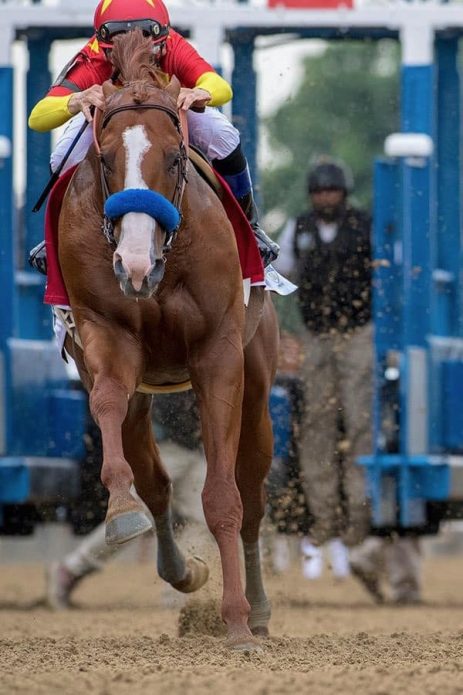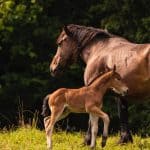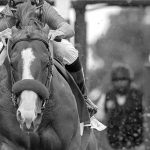
Though this post is dedicated to development of the hand, I often pull this photo of Hall of Fame jockey Mike Smith aboard 2018 Triple Crown winner Justify when teaching. It is a brilliant example of the effect of correct weight aid and a beautiful hand made more clear to the eye due to the extreme of the rider’s seat, the type of request, and the horse’s speed.
Weight
The first thing that catches my eye is that Mike wishes to change lanes and so places his weight over the horse’s right shoulder (not in overcorrection, but directly in line with where he wishes their new center of gravity to be.)
And we see the result of that request, yes? Justify leans in response to the weight aid, and alters his course just slightly. Look carefully at the rein and hand, and you will see that no rein aid is needed to ask the horse to change lanes. Mike uses only his weight for this shift. This is efficient (and in my opinion, kind!) riding. In other words, it’s less tiring not only for the rider, but also for the horse.
In dressage, that efficiency – a subtlety that results in the preservation of energy – may give you greater impulsion in a movement. In racing it will preserve for you a last kick of speed at the finish line. In jumping, that efficiency may be the difference in clearing a top rail cleanly when everyone else in your class has knocked it.
Hand
In prior posts, we have talked of this range of upper body position and leg required when riding (Fundamentals: On The Leg (Part 1 of 2)). For example, if you are sitting too far back on the horse and he jumps forward, you will assuredly be left behind. If your body is too far forward and he stops suddenly, maybe you will go over the horse’s head. There is a time and place for extreme positioning, but when you statically stay too far behind or too far forward and something unexpected happens, your response is too delayed either way for the correction and/or position needed. The same goes for the hand that stays in one extreme or the other (all the way open, or closed tight as a fist).
With the hand, we can go from closed to very open fingers, and most of the time when riding, we want to be mainly in the “neutral”/middle position of that range so we can get to either extreme more easily, more quietly, and more quickly when needed. When we stay in extremes, we lose the “perfect timing” that all riders aspire to.
So, we see here a very open hand that is “sending” Justify away from the gates and asking for maximum speed. Mike is asking this horse to reach forward, yet he retains a steadying contact with the mouth. He does not pull backwards or otherwise impede the forward momentum he requires, but neither is there a loop in the rein. In dressage, we call this responsiveness of the hand, a hand that follows.
You will find that the more sensitive and refined you can make your hand, the more horses you will be able to get along with and ride well. On an individual basis, the degree and quality of our contact should always first start with the personal preference of the horse, with the expectation that that contact will further change as the horse develops through training. If you have a horse that abhors contact with the mouth, resolve this problem before attempting to advance in other areas of training, for false movements and other difficulties will ensue if you do not address it.
The Hand According to la Gueriniere
The oft stated father of classical dressage, Francois Robichon de La Gueriniere (1688 – 1751), also speaks of this range of hand in his treatise, Ecole de Cavalerie, where he defines it in three types (I have added to the descriptions below to help with clarity):
- The Light Hand: the hand feels the lips of the horse, but does not feel contact of the bit with the bars of mouth
- The Gentle Hand: the horse feels the effect of the bit but the rider does not give too forceful a contact
- The Firm Hand: the horse is held in full contact and the greatest amount of support is given
Note that I relate a firm hand as being supportive to the horse – such a hand helps in balance and accuracy, but never is used to forcibly/manually manipulate position, as you block the shoulder and lose the back and hind when you do so. If you have ever had a very good dance partner, then you will understand these degrees of contact that allow you to interchangeably be led and to lead (and imperceptibly so to your audience). If the touch is too light, you will miss the telegraphing of your partner’s next move and at times be out of sync with each other. If the touch is too heavy, then one of you will at times look like a rag doll being dragged about the floor.
In la Gueriniere’s time, it was considered a great art to have such a range in the hand, and still today, such a hand is revered by horsemen the world over.
Practical Use
Outside of theory, it is a wise rider who works on the hand until the above becomes second nature, because it allows both rider and horse to react to each other very sensitively, quickly, and with more brilliance.
Here are a few additional situations that an attentive hand and leg will allow you to approach with a great deal of confidence:
- When in close quarters in a crowd of people, or with other horses (a busy warm-up ring, for example)
- When riding a young or skittish horse in a new environment
- Training or showing at a level when timing and responsiveness is a priority, such that the horse is able to execute very exactly from movement to movement
It also gives us more options and greater security when things go wrong. In that moment before a buck, a bolt, or a duck to the right or left, the horse will always (*see note below) telegraph the movement before it can be seen with the eye. In that moment before, we are granted what those from the ground see as “premonition” but is not: a split second where we are given the time to choose to either redirect or chastise the horse before a potentially dangerous escalation occurs.
A horse can react more confidently with such an attentive rider, and it is the same across disciplines with only variations in the degree of the position, and the angles required for the movement requested.
In this image of Mike and Justify, horse and rider are as one. It is a stunning shot, and truly beautiful riding!
The horse is the best judge of a good rider. Not the viewer. If the horse has a good opinion of the rider, they give to the guide. If not, they will resist.
Nuno Oliveira
*Adjunct Lesson on Telegraphing:
Of the thousands of horses I have ridden over the years, there have been a handful of horses that other riders have sworn did not telegraph. However, upon riding them myself, I found that all of them but one did.
That single horse that did not telegraph, was quite dangerous indeed and it was a very unusual case. It is truly a rarity and most riders will not encounter such a horse in their lifetime.
In fact, you are likely already better at detecting telegraphs than you think. When you want to halt but you know your horse will make several more steps after your request, or when you ask for canter and you know you will not get the right lead (or conversely, when you know you will nail it!), it is not because you are a mind reader, but because you are accurately listening to those subtle sensitivities you have developed in your hand, seat and leg. Your instructor will help you understand the source of the impediment you feel – a lazy hind leg perhaps, a blocked shoulder, etc – and give you tools to resolve them.
Achieve this, congratulate yourself, and then keep working at it! Can you feel each leg in every gait? Can you feel the hind motion in your hand? In addition to improving your timing and accuracy, this level of awareness helps to determine lamenesses. After that, can you tell where the lameness is? Then, narrow it down even further to which joint or ligament or tendon is causing the lameness? Do you have control over every leg as well as your horse’s hind-fore weight distribution? So much of fine riding is attributable to the sensitivity, fluidity and responsiveness of your contact points.
Every step that you take in this direction will put you in closer relationship with your horse. So, make the answers to these questions goals to work towards as you advance…and never forget that the joy is in the journey! In doing so, you will learn much of your horse and make friends with many more along the way.
Euki is the founder of Adaptive Development EQ and currently coaching and consulting in Denver, Colorado. She loves helping people get inspired about the developmental process of holistic/whole-horse training, and is on a mission to help riders and owners rediscover their horses, and fall in love with them all over again.






